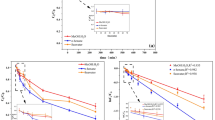Abstract
The purpose of this experiment was to determine the rate of photolysis for 2,4-dinitrotoluene (2,4-DNT) and 2,6-dinitrotoluene (2,6-DNT) in salt water and pure water, examine the influence of salt concentration on the photolysis rate, and to identify the products of the photolysis of 2,4-DNT and 2,6-DNT in seawater. For the photolysis of 2,4-DNT in pure water, the half-life was longer than 100 h, whereas the photolysis half-life in salt water was ~15 h. For 2,6-DNT, the pure water photolysis half-life was close to 20 h, but the salt water photolysis half-life was only 5 h. The photolysis rate for 2,6-DNT in seawater was affected by the ionic strength of the parent solution and was independent of the identity of the salt. The photolysis of both DNTs in seawater resulted in a complex mixture of products that exhibit a distinct yellow color. Analysis by gas and liquid chromatography mass spectroscopy (GCMS, LCMS) following liquid–liquid extraction or solid phase extractions resulted in the confirmation of the corresponding dinitrobenzaldhydes and dinitrobenzoic acids as photolysis products and a probable azoxy compound among the photolysis products in seawater.








Similar content being viewed by others
References
Benigni R, Andreoli C, Giuliani A (1989) Interrelationships among carcinogenicity, mutagenicity, acute toxicity, and chemical structure in a genotoxicity data base. J Toxicol Environ Health 27:1–20
Brezonik P, Fulkerson-Brekken J (1998) Nitrate-induced photolysis in natural waters: control on concentration of hydroxyl radical photo-intermediates by natural scavenging agents. Environ Sci Technol 32:3004–3010
Burlinson NE, Sitzmann ME, Glover DJ, Kaplan LA (1979) Photochemistry of TNT and related nitroaromatics: part III. NSWC/WOL TR 78–198. Naval Surface Weapons Center, Silver Spring
Celin SM, Pandit M, Kapoor JC, Sharma RK (2003) Studies of photo-degradation of 2, 4-dinitrotoluene in aqueous phase. Chemosphere 53:63–69
Chiron S, Minero C, Vione D (2006) Photodegradation processes of the antiepileptic drug barbamazepine, relevant to estuarine waters. Environ Sci Technol 40:5977–5983
Dave G, Nilsson E, Wernersson AS (2000) Sediment and water phase toxicity and UV-activation of six chemicals used in military explosives. Aquat Ecosyst Health Manag 3:291–299
Dillert R, Brandt M, Fornefett I, Bahnemann D (1995) Photocatalytic degradation of trinitrotoluene and other nitroaromatic compounds. Chemosphere 30:2333–2341
Hashimoto A, Sakino H, Kojima T, Yamagami E, Tateishi S, Akiyama T (1982) Sources and behavior of dinitrotoluene isomers in sea-water. Water Res 16:891–897
Ho PC (1986) Photooxidation of 2, 4-dintrotoluene in aqueous solution in the presence of hydrogen peroxide. Environ Sci Technol 20:260–267
Kaplan LA, Burlinson NE, Sitzmann ME (1975) Photochemistry of TNT: investigation of the “Pink Water” problem, Part II., Naval Surface Weapons Center, White Oak Laboratory, Silver Spring, Maryland, Technical Report 75-152
Larson RA, Miller PL, Crowley TO (1996) Borohydride photoreduction of nitroaromatic compounds related to military ordnance constituents. Environ Sci Technol 30:1192–1197
Larson RA, Jafvert CD, Bosca F, Marley KA, Miller PL (2000) Effects of surfactants on reduction and photolysis (>290 nm) of nitroaromatic compounds. Environ Sci Technol 34:505–508
Liou M-J, Lu M-C, Chen J-N (2003) Oxidation of explosives by fenton and photo-fenton processes. Water Res 37:3172–3179
Luning Prak DJ, O’Sullivan DW (2006) Solubility of 2, 4-dinitrotoluene and 2, 4, 6-trinitrotoluene in seawater. J Chem Engin Data 51:448–450
Luning Prak DJ, O’Sullivan DW (2007) Solubility of 4-nitrotoluene, 2, 6-dinitrotoluene, 2, 3-dinitrotoluene, and 1, 3, 5-trinitrobenzene in pure water and seawater. J Chem Eng Data 52:2446–2450
Mateus MCDA, Da Silva AM, Burrow HD (2000) Kinetics of photodegradation of the fungicide fenarimol in natural waters and in various salt solutions: salinity effects and mechanistic considerations. Water Res 23:1119–1126
Mihas O, Kalogerakis N, Psillakis E (2007) Photolysis of 2, 4-dinitrotoluene in various water solutions: effect of dissolved species. J Hazard Mater 146:535–539
Milagros SS, Zepp RG (1986) Influence of humic substances on the photolysis of nitroaromatic compounds in aqueous systems. Water Res 20:899–904
Millero FJ (2001) Physical chemistry of natural waters. Wiley-Interscience, John Wiley, New York, NY
Millero FJ (2006) Chemical oceanography, 3rd edn. CRC Press, Taylor and Francis Group, Boca Raton, FL
National Institute for Occupational Safety and Health (NIOSH) (1985) Current intelligence bulletin 44: Dinitrotoluenes, DHHS (NIOSH) Publication No. 85-109, Cincinnati, OH
Nipper M, Qian Y, Carr RS, Miller K (2004) Degradation of picric acid and 2, 6-DNT in marine sediments and water: the role of microbial activity and ultra-violet exposure. Chemosphere 56:519–530
O’Sullivan DW, Neale PJ, Coffin RB, Boyd TJ, Osburn CL (2005) Photochemical production of hydrogen peroxide and methylhydroperoxide in coastal waters. Mar Chem 97:14–33
Pennington JC, Thorn KA, Cox LG, MacMillan DK, Yost S, Laubscher RD (2007) Photochemical degratdation of composition B and its components. Engineer Research and Development Center, Technical Report, ERDC/EL TR-07-16
Rodgers JD, Bunce NJ (2001) Treatment methods for the remediation of nitroaromatic explosives. Water Res 35:2101–2111
Schmelling DC, Gray KA, Kamat PV (1996) Role of reduction in photocatalytic degradation of TNT. Environ Sci Technol 30:2547–2555
Simmon MS, Zepp RG (1986) Influence of humic substances on photolysis of nitroaromatic compounds in aqueous systems. Water Res 20:899–904
Site and Radiological Assessment Branch (SRAB), Division of Health Assessment and Consultation, and Agency for Toxic Substances and Disease Registry (2007) Health Consultation: Ordnance Reef, Wai’anae, Honolulu County, Hawaii, U.S. Department of Health and Human Services, 16 October 2007
Skrabal SA (1995) Distributions of dissolved titanium in Chesapeake Bay and the Amazon River Estuary. Geochim Cosmochim Acta 59:2449–2458
Zepp RG, Holgne J, Bader H (1987) Nitrate-induced photooxidation of trace organic chemicals in water. Environ Sci Technol 21:433–450
Acknowledgments
The authors wish to thank Ms. Jackie Brown and Ms. Kristine Selde for their assistance with the analytical equipment. This work was supported by Strategic Environmental Research and Development Program through ER-1431 to DWO.
Author information
Authors and Affiliations
Corresponding author
Rights and permissions
About this article
Cite this article
O’Sullivan, D.W., Denzel, J.R. & Luning Prak, D.J. Photolysis of 2,4-Dinitrotoluene and 2,6-Dinitrotoluene in Seawater. Aquat Geochem 16, 491–505 (2010). https://doi.org/10.1007/s10498-010-9089-9
Received:
Accepted:
Published:
Issue Date:
DOI: https://doi.org/10.1007/s10498-010-9089-9



